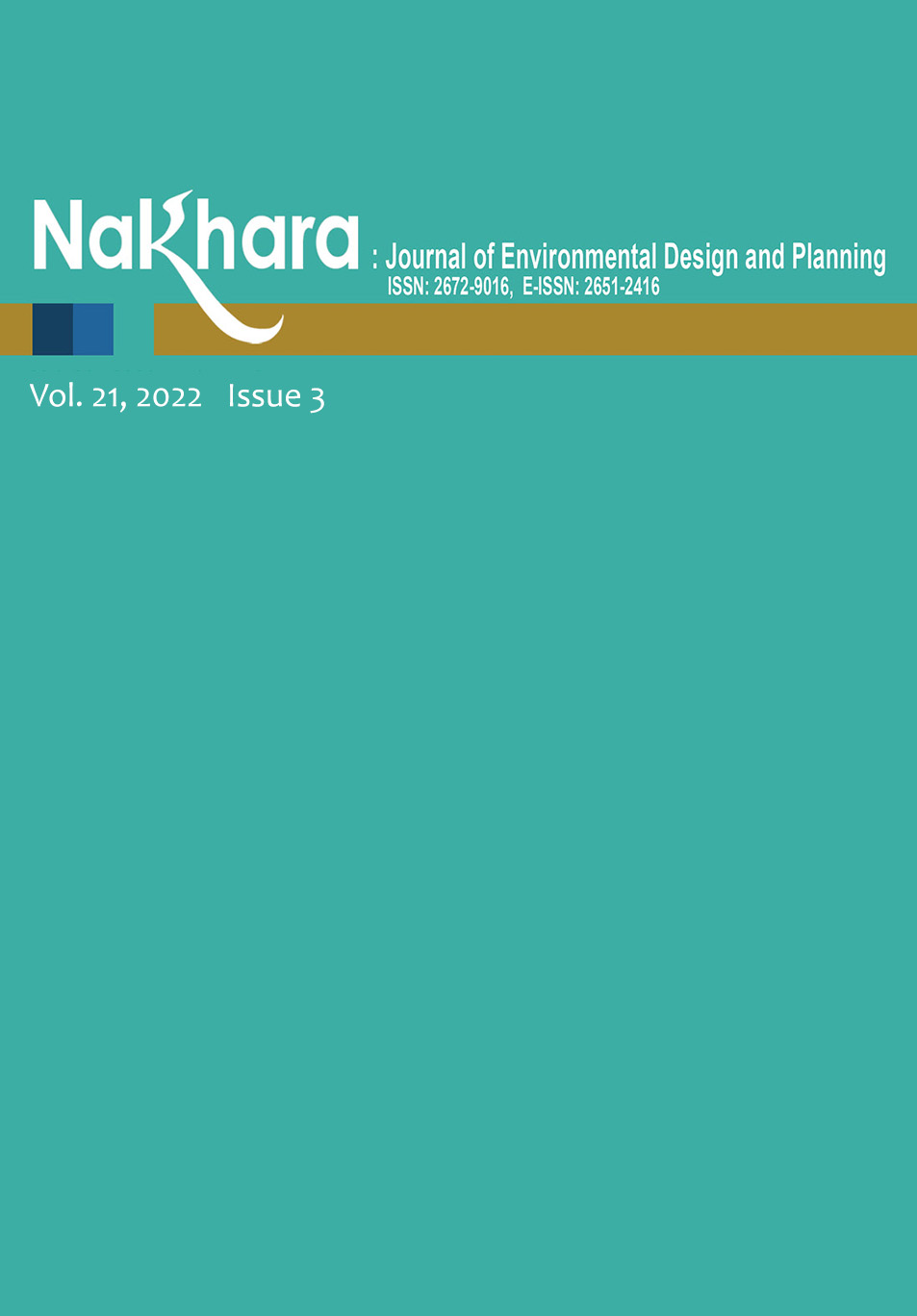The Analytical Tools for Tourism Development through Social Media Data and Spatial Morphological Analysis
Main Article Content
Abstract
In the tourism sector, social media data help elucidate the travel behavior and activities of travelers through images and reviews. However, geospatial studies with spatial analysis tools such as GIS are still required by researchers who hope to gain beneficial insight into tourism development from such social media data. In addition to spatial studies, Space syntax analysis is used to explain the spatial characteristics and accessibility of both pedestrians and vehicles; however, the method doesn't consider how people use the space. Therefore, using social media with space syntax analysis will help enhance the understanding of both tourism and spatial aspects. This research aims to develop analytical tools to support tourism studies with the GIS (graphic information system) process using social media data analysis and spatial morphological results from space syntax analysis. The study found that the accessibility potential of a destination does not enhance the popularity of tourist attractions as much as relevant images or attractions due to many popular tourist attractions being located in areas with low potential accessibility. While the image processing and text processing results can extract hidden traits and identities in each attraction, another result is that the analytical tool developed in the study can help quantify tourism activities and perform preliminary content analysis of the data from text and Image processing through the GIS software. It is also used to overlay tourism activities and spatial morphology results in order to recognize the tourism development potential of the area in terms of destination image tourism activities and accessibilities. The tool produces useful results and assists in decision-making for the development of tourist attractions.
Article Details

This work is licensed under a Creative Commons Attribution-NonCommercial-NoDerivatives 4.0 International License.
References
Bafna, S. (2003). SPACE SYNTAX a brief introduction to its logic and analytical techniques. Environment and Behavior, 35(1), 17–29.
2. Casado-Aranda, L., Sánchez-Fernández, J., & Bastidas-Manzano, A. (2021). Tourism research after the COVID-19 outbreak: Insights for more sustainable, local and smart cities. Sustainable Cities and Society, 73, 103126.
Crucitti, P., Latora, V., & Porta, S. (2006). Centrality in network of urban streets. Chaos, 16, 015113.
Ginzarly, M., Pereira Roders, A., & Teller, J. (2018). Mapping historic urban landscape values through social media. Journal of Cultural Heritage, 36. https://doi.org/10.1016/j.scs.2021.103126.
Hillier, B., & Hanson, J. (1984). The social logic of space. Cambridge University Press.
Hillier, B., Penn, A., Hanson, J., Grajewski, T., & Xu, J. (1993). Natural movement: or, configuration and attraction in urban pedestrian movement. Environment and Planning B: Urban Analytics and City Science, 20 (1), 29–66.
Hillier, B., Yang, T., & Turner, A. (2012). Normalising least angle choice in depthmap - and how it opens up new perspectives on the global and local analysis of city space. Journal of Space Syntax, 3(2), 155–193.
Ince, E., Iscioglu, D., & Öztüren, A. (2020). Impacts of cittaslow philosophy on sustainable tourism development. Open House International, 45(1/2), 173–193.
Jang, H., & Park, M. (2020). Social media, media and urban transformation in the context of overtourism. International Journal of Tourism Cities, 6(1), 233–260.
10. Kádár, B., & Gede, M. (2013). Where Do Tourists Go? Visualizing and Analysing the Spatial Distribution of Geotagged Photography. Cartographica: The International Journal for Geographic Information and Geovisualization, 48(2). 78–88.
Li, J., Weng, G., Pan, Y., Li, C., & Wang, N. (2021). A scientometric review of tourism carrying capacity research: Cooperation, hotspots, and prospect. Journal of Cleaner Production, 325, 129278.
Li, Y., Ye, Y., Longzhu, X., Xu, W., Law, A., & Wang, D. (2017). Classifying community space at a historic site through cognitive mapping and GPS tracking: The case of Gulangyu, China. URBAN DESIGN International, 22, 127–149.
Mandic, A., & Kennell, J. (2021). Smart governance for heritage tourism destinations: Contextual factors and destination management organization perspectives. Tourism Management Perspectives, 39, 100862.
14. Mao, T. (2015). Mining One Hundred Million Creative Commons Flickr Images Dataset to Flickr Tourist Index. International Journal of Future Computer and Communication, 4(2). 104–107.
15. Miah, S., Vu, H., Gammack, J., & McGrath, M. (2017). A big data analytics method for tourist behaviour analysis. Information & Management, 54(6), 771–785.
16. Mirzaalian, F., & Halpenny, E. (2021). Exploring destination loyalty: Application of social media analytics in a nature-based tourism setting. Journal of Destination Marketing & Management, 20, 100598.
17. Mohamed, A., & Stanek, D. (2020). The influence of street network configuration on sexual harassment patterns in Cairo. Cities, 98, 102583.
Park, S., Kim, J.-W., Lee, Y. K., & Ok, C. (2020). Visualizing theme park visitors' emotions using social media analytics and geospatial analytics. Tourism Management, 80, 104127.
19. Payntar, D. N., Hsiao, W., Covey, R. A., & Grauman, K. (2021). Learning patterns of tourist movement and photography from geotagged photos at archaeological heritage sites in Cuzco, Peru. Tourism Management, 82, 104165.
20. Rezvani, M., Nickravesh, F., & Astaneh, A. & Kazemi, N. (2022). A risk-based decision-making approach for identifying natural-based tourism potential areas. Journal of Outdoor Recreation and Tourism, 37, 100485.
Sheungting L. I., McKercher, B., Lo, A., Cheung, C., & Law R. (2011). Tourism and online photography. Tourism Management, 32(4), 725–731.
Sigala, M., Kumar, S., Donthu, N., & Joshi, Y. (2021). A bibliometric overview of the Journal of Hospitality and Tourism Management: Research contributions and influence. Journal of Hospitality and Tourism Management, 47, 273–288.
23. Volgger, M., Erschbamer, G., & Pechlaner, H. (2021). Destination design: New perspectives for tourism destination development. Journal of Destination Marketing and Management, 19, 100561.

